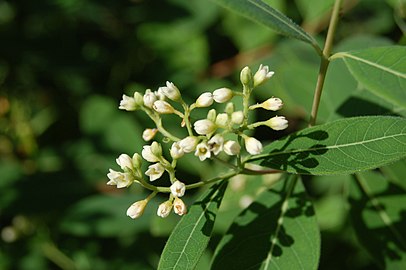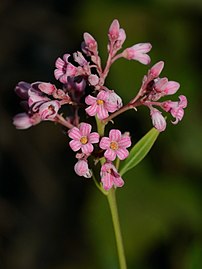Apocynum
| Apocynum | |
|---|---|

| |
| Apocynum androsaemifolium | |
| Scientific classification | |
| Kingdom: | Plantae |
| Clade: | Tracheophytes |
| Clade: | Angiosperms |
| Clade: | Eudicots |
| Clade: | Asterids |
| Order: | Gentianales |
| Family: | Apocynaceae |
| Subfamily: | Apocynoideae |
| Tribe: | Apocyneae |
| Genus: | Apocynum L. |
| Synonyms[1] | |
| |
Apocynum, commonly known as dogbane[2] or Indian hemp,[2] is a small genus of the flowering plant family Apocynaceae. Its name comes from Ancient Greek ἀπόκυνον apókunon, from ἀπο- apo- "away" and κύων kúōn "dog",[3] referring to dogbane (Cionura erecta),[4] which was used to poison dogs.[5] The genus is native to North America, temperate Asia, and southeastern Europe.[1][6][7]
Apocynum species are used as food plants by the larvae of some Lepidoptera species, including the mouse moth and the queen butterfly.
Uses
Apocynum cannabinum is used as a source of fiber by Native Americans. Apocynum venetum (Chinese: 羅布麻) is used as an herbal tea in China.[8] Dogbane contains cymarin, a cardiotonic agent formerly used to treat cardiac arrhythmia in humans.[9]
Species
Almost 300 names have been proposed in the genus for species, subspecies, and forms.[1] As of 2019[update], only the following five species and hybrids are currently recognized, with several subspecies and varieties accepted for A. androsaemifolium and A. venetum (see their respective species pages).[10]
- Apocynum androsaemifolium L. – Canada, United States, northeastern Mexico
- Apocynum cannabinum L. – Canada, United States
- Apocynum × floribundum Greene (a hybrid of A. androsaemifolium and A. cannabinum) – Canada, United States, northern Mexico
- Apocynum pictum Schrenk – China, Mongolia, Kazakhstan, Kyrgyzstan, Tajikistan
- Apocynum venetum L. – southeastern Europe and Asia
-
Flowers of Apocynum cannabinum
-
Leaves of Apocynum androsaemifolium
References
- ^ a b c "Apocynum". World Checklist of Selected Plant Families (WCSP). Royal Botanic Gardens, Kew. Retrieved May 21, 2014.
- ^ a b English Names for Korean Native Plants (PDF). Pocheon: Korea National Arboretum. 2015. p. 517. ISBN 978-89-97450-98-5. Archived from the original (PDF) on 25 May 2017. Retrieved 25 January 2016 – via Korea Forest Service.
- ^ http://www.co.jefferson.co.us/coopext/plantdetail.do?sna=Apocynum+androsaemifolium&image=0 Archived 2011-07-27 at the Wayback Machine Colorado Plant Database
- ^ ἀπόκυνον in Liddell, Henry George; Scott, Robert (1940) A Greek–English Lexicon, revised and augmented throughout by Jones, Sir Henry Stuart, with the assistance of McKenzie, Roderick. Oxford: Clarendon Press. In the Perseus Digital Library, Tufts University.
- ^ Dempster, Lauramay T. (1993). "Apocynum". In Hickman, James C. (ed.). The Jepson Manual: Higher Plants of California. University and Jepson Herbaria.
- ^ Li, Bingtao; Leeuwenberg, Antony J. M.; Middleton, David J. "Apocynum". Flora of China. Vol. 16 – via eFloras.org, Missouri Botanical Garden, St. Louis, MO & Harvard University Herbaria, Cambridge, MA.
- ^ "Apocynum". County-level distribution maps from the North American Plant Atlas (NAPA). Biota of North America Program (BONAP). 2013.
- ^ Xiong, Q; Fan, W; Tezuka, Y; Adnyana, IK; Stampoulis, P; Hattori, M; Namba, T; Kadota, S (2000). "Hepatoprotective effect of Apocynum venetum and its active constituents". Planta Med. 66 (2): 127–33. doi:10.1055/s-2000-11135. PMID 10763585. S2CID 25960011.
- ^ National Center for Biotechnology Information, U.S. National Library of Medicine, Cymarine
- ^ "Apocynum L." Plants of the World Online. Royal Botanical Gardens Kew. Retrieved 17 June 2019.
External links
 Media related to Apocynum at Wikimedia Commons
Media related to Apocynum at Wikimedia Commons



